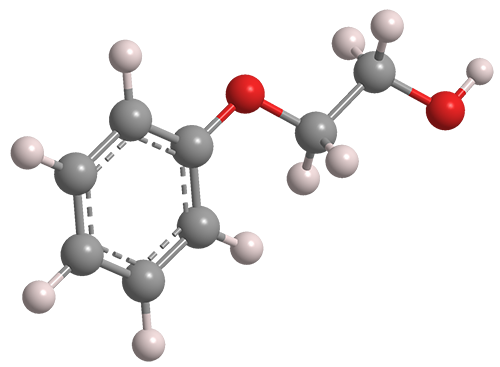What molecule am I?


2-Phenoxyethanol, known early on as ethylene glycol monophenyl ether, is a high-boiling, oily liquid that is moderately water-soluble. It has a long history and several uses in chemical manufacturing and consumer products.
The earliest mention of 2-phenoxyethanol in the chemical literature appeared in 1894, when Ernst Roithner at the University of Vienna published a treatise on ethylene oxide. In the article, Roithner described the synthesis of 2-phenoxyethanol via the reaction of ethylene oxide with phenol in a basic medium.
Two years later, in a paper about γ-phenoxy derivatives of malonic and acetic acids and the compounds used to synthesize them, William Henry Bentley, Edward Haworth, and William Henry Perkin, Jr.,* at Owens College (Manchester, UK) reported the preparation of 2-phenoxyethanol from sodium phenolate and ethylene chlorohydrin (2-chloroethanol). In 1919, R. E. Rindfusz at the University of Illinois (Urbana–Champaign) used this method to make 2-phenoxyethanol in the course of synthesizing chromanes (dihydrobenzopyrans) and coumaranes (dihydrobenzofurans). A refined version of Perkin et al.’s synthesis is used to manufacture 2-hydroxyethanol today.
2-Phenoxyethanol has many industrial uses—primarily as a solvent for dyes, inks, and resins; a lubricant preservative; and a reagent in organic chemical synthesis. In consumer products, its uses range from a preservative for cosmetics and drugs to a fixative for perfumes to an attractant in insecticides. In one ironic instance, it is a component of a hair formulation that claims to be “preservative-free”.
References to 2-phenoxyethanol often omit the numerical prefix, but this is ambiguous because of the existence of an isomer, 1-phenoxyethanol1. The isomer appears much less frequently in the chemical literature and has far fewer commercial uses.
1. CAS Reg. No. 56101-99-6.
2-Phenoxyethanol hazard information*
| Hazard class** | GHS code and hazard statement | |
|---|---|---|
| Acute toxicity, oral, category 4 | H302—Harmful if swallowed | |
| Serious eye damage/eye irritation, category 1 | H318—Causes serious eye damage | |
| Specific target organ toxicity, single exposure, respiratory tract irritation, category 3 | H335—May cause respiratory irritation | |
| Specific target organ toxicity, single exposure, narcotic effects, category 3 | H336—May cause drowsiness or dizziness | |
*Compilation of multiple safety data sheets.
**Globally Harmonized System (GHS) of Classification and Labeling of Chemicals. Explanation of pictograms.
Molecules from the journals
Phainanoids are triterpenoids found in the tropical shrub Paranephelium hainanensis that grows only on Hainan Island (China). These compounds, including (+)-phainanoid A1, are cytotoxic against some cancer cell lines and show immunosuppressive activity similar to that of the established drug cyclosporin A2. In February, Guangbin Dong and co-workers at the University of Chicago reported the asymmetric total synthesis of (+)-phainanoid A and some non–naturally occurring analogues. The authors validated these molecules’ immunosuppressive activities and discussed their structure–activity relationships.
Sodium selenogallate3 (NaGaSe2) is an inorganic compound that was first described in a 1998 European patent application by Matsushita (Osaka, Japan) for anodes in nonaqueous-electrolyte batteries. Additional uses for the substance have been reported since then, the latest by Amitava Choudhury and colleagues at Missouri University of Science and Technology (Rolla), Missouri State University (Springfield), and the Indian Institute of Science Education and Research (Bhopal). The structure of NaGaSe2 consists of adamantane-like Ga4Se10 building units connected to each other to form 2-D (GaSe2)n– layers. The authors report that NaGaSe2 “has an unusual ability to absorb water molecules from the atmosphere or a nonanhydrous solvent.” The resulting NaGaSe2∙xH2O (x = 1–2) is easily dehydrated to its original form.
1. CAS Reg. No. 1643933-50-9.
2. CAS Reg. No. 59865-13-3.
3. CAS Reg. No. 216600-22-5.
Molecules from the Journals
MOTW briefly describes noteworthy molecules that appeared in recent ACS journal articles. See this week's
edition below.
This molecule was suggested by a reader. We present almost all of the molecules suggested by our readers. If you have a molecule you would like us to consider, please send us a message. And thank you for your interest in Molecule of the Week! —Ed.
2-Phenoxyethanol
fast facts
| CAS Reg. No. | 122-99-6 |
| SciFinder nomenclature | Ethanol, 2-phenoxy- |
| Empirical formula | C8H10O2 |
| Molar mass | 138.16 g/mol |
| Appearance | Colorless, oily liquid |
| Boiling point | 245–247 °C |
| Water solubility | 27 g/L (20 °C) |

Learn more about this molecule from CAS, the most authoritative and comprehensive source for chemical information.
Molecule of the Week needs your suggestions!
If your favorite molecule is not in our archive, please send us a message. The molecule can be notable for its current or historical importance or for any quirky reason. Thank you!
Stay Ahead of the Chemistry Curve
Learn how ACS can help you stay ahead in the world of chemistry.

